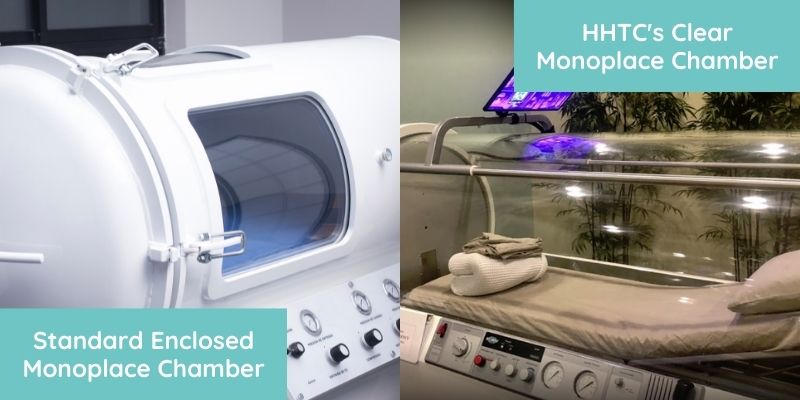Top five most common side effects of hyperbaric oxygen therapy
Ease your anxieties and prepare for all possibilities by diving into the side effects of hyperbaric treatments
Despite being a generally safe procedure, one of the top concerns of new hyperbaric oxygen therapy (HBOT) patients is the side effects of taking a dive. Like all medical treatments, there are possible side effects to HBOT, but they are minimal or temporary at most.
Join us to explore the most common hyperbaric oxygen therapy side effects before your treatment, plus learn how our team at Hyperbaric Healing Treatment Center ensures a safe healing experience for each of our beautiful patients.
#1: Middle ear barotrauma
As the most common side effect of HBOT, middle ear barotrauma sounds more drastic than it is in reality.
Middle ear barotrauma is a form of pressure, pain, or discomfort in your ears during the initial compression phase of HBOT. It happens when the middle ear has difficulty equalizing the pressure on both sides of the eardrum during the dive due to the increased atmospheric pressure in the chamber.
One study conducted to determine the incidence rate of the condition found that 43.2% of patients experienced middle ear barotrauma from HBOT. [1]
If you’re treated by a certified and trained medical staff, they will have protocols in place to coach you prior to treatment on ways to clear your ears as you undergo compression to avoid or mitigate the effects of ear pain.
In the event that you do experience middle ear barotrauma, most cases are only short-term and resolve once you stop repetitively undergoing HBOT treatments. If you experience lingering symptoms, there are certain topical medications and procedures that can be used to fix the problem. [2]
#2: Vision changes
Another common side effect that occurs during HBOT treatment is minor and temporary changes in vision, usually presenting as nearsightedness (myopia) caused by temporary eye lens changes.
These vision changes are caused by the effects of the atmosphere of 100% oxygen on the curvature of the eye’s lens, most often appearing during a course of 20 or more hyperbaric treatments.
One study analyzing the rates of visual acuity change in HBOT patients found that a total of 60% of patients had some level of temporary change in visual acuity after treatment as evidenced by an eye exam with a Snellen eye chart. [3]
If you experience vision changes, it will subside days to weeks after your last treatment. Since your vision will return to normal, it is not necessary to change your eyeglass or contact prescription.
#3: Sinus squeeze
In a similar fashion as middle ear barotrauma, HBOT can also cause pressure on the sinuses, often called sinus squeeze.
Sinus squeeze is caused by inability to equalize pressure in the chamber, and is most often felt by patients in the frontal sinuses. The symptoms can include pressure, congestion, and swelling in the sinus cavities.
Those with an upper respiratory infection can also face sinus squeeze turning into upper airway inflammation, so it’s recommended that patients not get elective HBOT until their infection is resolved.
#4: Oxygen toxicity
Although rare in a clinical setting, another possible side effect of HBOT is oxygen toxicity which is caused by over exposure to oxygen.
Oxygen toxicity can present in a variety of ways such as seizure, chest pain, and difficulty breathing depending on the unique set of circumstances. All of the symptoms are resolved once the supplemental oxygen is removed from the patient.
The most recent evidence reports the incidence of oxygen toxicity as approximately one in every 2,000–3,000 treatments. [2]
Oxygen toxicity is more common in patients taking certain medications or battling specific preexisting conditions, which is why it’s essential to receive treatments from a center that evaluates each patient with a hyperbaric trained physician.
Many treatment centers avoid risk of oxygen toxicity for their patients by making time for air breaks. Air breaks are short pauses during HBOT treatments where patients breathe normal air to prevent tissues in the body from absorbing too much oxygen.
#5: Claustrophobia
Especially in the enclosed space of a monoplace hyperbaric chamber, some patients may experience feelings of claustrophobia during treatments.
Symptoms of claustrophobia can include sweating, palpitations, increased blood pressure, light-headedness, and anxiety. [2]
Claustrophobia is easily avoided for most patients by undergoing proper preventative measures with trained hyperbaric professionals before treatment. Sharing any past medical history of claustrophobia or other conditions, being educated about what to expect from HBOT, and reassurance and coaching from a hyperbaric safety director can make you feel more safe and secure before your first dive.
There are also certain therapies and relaxation exercises that can be done to help patients with more severe cases of claustrophobia undergo HBOT treatments.
Unlike most monoplace chambers, the state of the art Sechrist 3600 monoplace hyperbaric chambers at Hyperbaric Healing Treatment Center (HHTC) are made of crystal clear acrylic. Once you’re inside the chamber, the clarity of the acrylic makes it feel as though you are not in an enclosed space at all.
“I have friends who have used other facilities’ chambers which are totally different from HHTC’s and they have told me they’ve nearly had panic attacks in them,” shares our patient Deanna D. on Google reviews. “I’m claustrophobic and this did not phase me one bit. I closed my eyes as they pushed me through the hole into the chamber and once inside I opened them and never felt stuck, enclosed or anything else. The acrylic is so crystal clear and clean that you can’t tell where it is unless you were to reach out and touch it.”

To conclude
Although there are possible side effects to HBOT, they are minor and temporary. For most patients, there is minimal risk at the depths and durations of a dive at most medical centers.
HBOT does not have narcotic type effects, and most patients tolerate the treatments very well. Your existing daily activities will not be interrupted by undergoing treatments, and it’s safe for you to drive yourself to and from your HBOT appointments.
Patient safety is our top priority!
At Hyperbaric Healing Treatment Center, our highly-trained, compassionate team of hyperbaric professionals follow best practices to ensure each patient undergoes the safest healing journey possible.
Each patient undergoes our New Patient Orientation where our Safety Director will go over any and all questions or concerns you may have prior to treatment. Our Safety Director will also review the safety measures that you’ll be reminded of before every session to ensure you’re secure amid the increased oxygen concentration and atmospheric pressure.
Still left with questions or concerns?
Our trained, caring team of hyperbaric specialists are ready to give you all the answers before your treatments! We welcome you to contact us today.
Sources:
1: Europe PMC | Middle ear barotrauma in hyperbaric oxygen therapy.
2: National Library of Medicine (NLM) | Hyperbaric Oxygen Therapy: Side Effects Defined and Quantified

